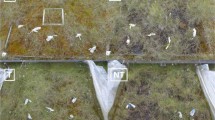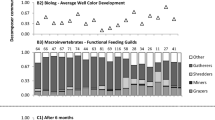Summary
The hypothesis that moss peat respiration in the maritime Antarctic was dependent more on edaphic conditions, substrate quality and microflora than latitude was broadly supported by studies on a 14° transect in 1980–81. Oxygen-uptake and CO2-release of samples from Polytrichum and Drepanocladus communities at five locations were compared by ANOVA. Regression analysis showed moisture and temperature to be prime regulators. A strong but unquantifiable influence of substrate quality was inferred. The influence of microbial biomass was blurred by variation. the absence in Polytrichum of significant multiple regressions of respiration with moisture and temperature implied stable respiration during a summer period of relatively invariable moisture, pH, Eh and potential substrate availability. Conversely, the occurrence of Drepanocladus in a broader range of moisture conditions yielded a significant regression. When extrapolated to estimate annual C-loss, this was similar to estimates for the 1975–77 seasons at Signy Island which was thereby shown to represent the maritime Antarctic.
Similar content being viewed by others
References
Bliss CI (1975) Statistics in biology, vol II. McGraw-Hill, New York
Brown J, Veum AK (1974) Soil properties of the international Tundra Biome sites. In: Holding AJ, Heal OW, Maclean SF, Flanagan PW (eds) Soil organisms and decomposition in Tundra. Tundra Biome Steering Committee, Stockholm, pp 27–48
Bunnell FL, Scoullar K (1975) ABISKO II — computer simulation model of carbon flux in tundra ecosystems. In: Rosswall T, Heal OW (eds) Structure and function of Tundra ecosystems. Ecol Bull 20:425–448
Bunnell FL, Maclean SF, Brown J (1975) Barrow, Alaska, USA. In: Rosswall T, Heal OW (eds) Structure and function of Tundra ecosystems. Ecol Bull 20:73–124
Bunnell FL, Tait DEN, Flanagan PW, Van Cleve K (1977) Microbial respiration and substrate weight loss. 1. A general model of the influence of abiotic variables. Soil Biol Biochem 9:33–40
Clymo RS, Reddaway EJF (1971) Productivity of Sphagnum (bog moss) and peat accumulation. Hidrobiol 12:181–192
Collins NJ, Baker JH, Tilbrook PJ (1975) Signy Island, maritime Antarctic. In: Rosswall T, Heal OW (eds) Structure and function of Tundra ecosystems. Ecol Bull 20:345–374
Davis RC (1981) Structure and function of two Antarctic terrestrial moss communities. Ecol Monogr 51:125–143
Fenton JHC, Smith RIL (1982) Distribution, composition and general characteristics of the moss banks of the maritime Antarctic. Br Antarct Surv Bull 51:215–236
Flanagan PW, Veum AK (1974) Relationships between respiration, weight loss, temperature and moisture in organic residues in tundra. In: Holding AJ, Heal OW, Maclean SF, Flanagan PW (eds) Soil organisms and decomposition in Tundra. Tundra Biome Steering Committee, Stockholm, pp 249–278
Gimingham CH, Smith RIL (1970) Bryophyte and lichen communities in the maritime Antarctic. In: Holdgate MW (ed) Antarctic ecology. Academic Press, London New York, pp 752–758
Heal OW, Flanagan PW, French DD, Maclean SF (1981) Decomposition and accumulation of organic matter in tundra. In: Bliss LC, Heal OW, Moore JJ (eds) Tundra ecosystems: A comparative analysis. Cambridge University Press, Cambridge London, pp 587–635
Janac J, Catsky J, Jarvis PG (1971) Infra red gas analysers and other physical analysers. In: Sestak Z, Catsky J, Jarvis PG (eds) Plant photosynthetic production. Manual of Methods. W Junk, The Hague, pp 111–197
Kjelvik S, Wielgolaski FE, Jahren A (1975) Photosynthesis and respiration of plants studied by field techniques at Hardangervidda, Norway. In: Wielgolaski FE (ed) Fennoscandian Tundra ecosystems. Part 1: Plants and microorganisms. Springer, Berlin Heidelberg New York, pp 184–193
Martin NJ, Parkinson D (1978) Effect of starvation on survival of three bacterial isolates from an arctic soil. Can J Microbiol 12:1460–1467
Peterson KM, Billings WD (1975) Carbon dioxide flux from tundra soils and vegetation as related to temperature at Barrow, Alaska. Am Midl Naturalist 94:88–98
Smith RIL (1982) Farthest south and highest occurrences of vascular plants in the Antarctic. Polar Rec 21:170–174
Svensson BH (1980) Carbon dioxide and methane fluxes from the ombrotrophic parts of a subarctic mire. In: Sonesson M (ed) Ecology of a subarctic mire. Ecol Bull 20:235–250
Svensson BH, Rosswall T (in press) In situ methane production from acid peat in plant communities with different moisture regimes in a subarctic mire. Holarct Ecol
Svensson BH, Veum AK, Kjelvik S (1975) Carbon losses from tundra soils. In: Wielgolaski FE (ed) Fennoscandian Tundra ecosystems. Part 1: Plants and microorganisms. Springer, Berlin Heidelberg New York, pp 279–286
Tilbrook PJ (1973) The Signy Island terrestrial reference sites. 1. An introduction. Br Antarct Surv Bull 33 and 34:65–76
Walton DWH (1977) Radiation and soil temperatures 1972–74: Signy Island terrestrial reference sites. Br Antarct Surv Data 1:1–49
Wynn-Williams DD (1979) Techniques used for studying terrestrial microbial ecology in the maritime Antarctic. Soc Appl Bacteriol Techn Ser 13:67–82
Wynn-Williams DD (1980) Seasonal fluctuations in microbial activity in Antarctic moss peat. Biol J Linn Soc 14:11–28
Wynn-Williams DD (1982) Simulation of seasonal changes in microbial activity of maritime Antarctic peat. Soil Biol Biochem 14:1–12
Wynn-Williams DD (in press) Comparative microbiology of moss peat decomposition on the Scotia Arc and Antarctic Peninsula. In: Siegfried WR, Condy P, Laws RM (eds) Nutrient cycling and food webs in the Antarctic: Proc 4th SCAR Symp Antarct Biol. Springer, Berlin Heidelberg New York Tokyo
Yarrington MC, Wynn-Williams DD (in press) Methanogenesis and the anaerobic microbiology of a wet moss community at Signy Island. In: Siegfried WR, Condy P, Laws RM (eds) Nutrient cycling and food webs in the Antarctic: Proc 4th SCAR Symp Antarct Biol. Springer, Berlin Heidelberg New York Tokyo
Author information
Authors and Affiliations
Rights and permissions
About this article
Cite this article
Wynn-Williams, D.D. Comparative respirometry of peat decomposition on a latitudinal transect in the maritime Antarctic. Polar Biol 3, 173–181 (1984). https://doi.org/10.1007/BF00442649
Received:
Accepted:
Issue Date:
DOI: https://doi.org/10.1007/BF00442649




